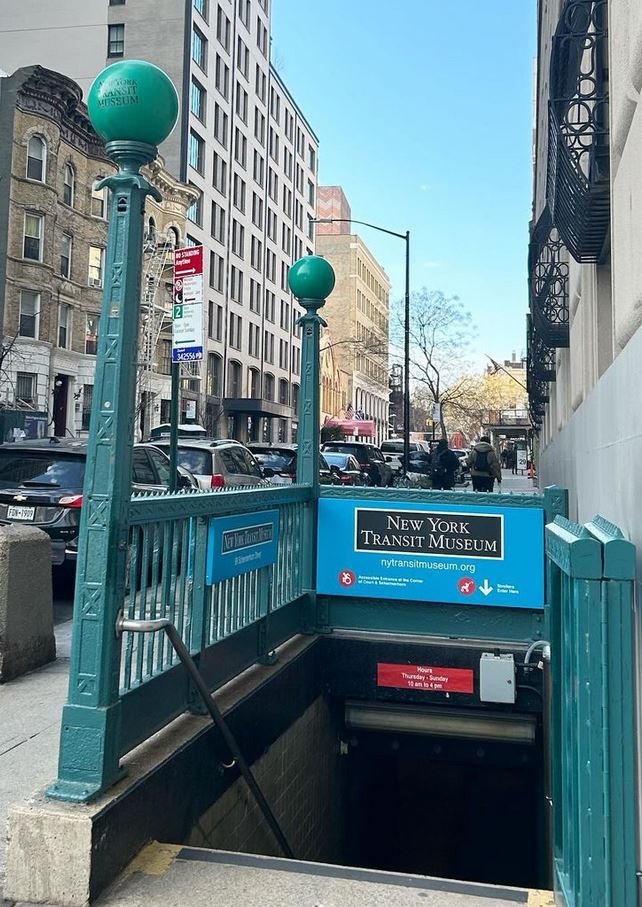Transit Museum

The New York Transit Museum showcases historical artworks from New York City’s subway, bus, commuter rail, and bridge and tunnel systems, under the supervision of the Metropolitan Transportation Authority (MTA).
The main museum is located in the old Court Street subway station, in the Brooklyn Heights neighborhood of New York. There is a smaller museum annex at Manhattan’s Grand Central Terminal.
On July 4, 1976, the New York City Transit exhibition was inaugurated in the disused subway station as part of the celebration of the 200th anniversary of the United States, with a subway ticket for admission. You could see old recovered cars, as well as scale models and other exhibits.
It was planned to close the exhibition after the celebrations, but it turned out to be so popular that it remained open and eventually became a permanent museum.
In addition, programs are offered outside the museum. These include tours of MTA facilities, subway stations, art and architecture, New York City neighborhoods, and access to old trains and bus equipment.
Layout of the museum
The upper level of the museum includes the majority of exhibits, toilets, coolers, a projection room and a dining room for visitors who have brought their own food. Handicrafts from the history of the subway and bus system, as well as the transport infrastructure of New York City, are on display. The exposures of the upper level change frequently.
On the platform level (lower), two fully operational subway lines contain numerous historical examples of New York City’s subway and elevated trains, which constitute a permanent exhibition.
Video
Preserved subway cars dating back several decades as well as a large wheeled truck, a motor, a switch the size of a refrigerator, a complete relay based on the classic electric motor, and many other objects highlighting topics such as subway signaling and control, electricity, railway infrastructure, station plans and works of art.
We can also see a fully functional underground control room, a facility that was used when the metro station was active.
The lights and controls in the track diagram are fully functional and are always used when the subway cars in the exhibition need to be replaced or moved.
Since the controls are real, the control panel is secured and locked, but visitors can see it through a window and read the explanatory panels.
Most of the subway cars in the Transit Museum’s fleet are functional and are often used for guided subway tours organized by the museum and New York City Transit in different parts of the system.
The subway cars are fully equipped with advertising signs and vintage road maps, which complements the vintage atmosphere in the cars. In addition to the metro cars on display at the Transit Museum, a number of museum cars are kept outside the site, in various garages and workshops of the metro, waiting to be restored, being restored or stored. In addition to the subway cars, the museum has a fairly large eclectic fleet of buses.
As there is no space available for their permanent exhibition in the underground museum, they are stored in various bus depots in the city.
They were purchased for special events, such as the museum’s “Bus Celebration”, which takes place every year at the same time as Atlantic Antic. The “bus celebration” became an annual tradition in 1994. During this period, the museum opens its doors and admission is free.
Documents, photographs and artifacts are stored both in the museum and in the nearby archives, thus contributing to the goal of preserving the heritage of New York’s transportation. Historians and researchers who wish to visit the archives can do so inside the museum. Some photos from the collection can also be seen on Historypin.
A gallery and a shop of the New York Transit Museum opened in 1993 at Grand Central Terminal, in the main hall of the terminal. It houses a shop offering museum-related gift items, as well as an area for temporary exhibitions.
The annex is the site of the annual “Holiday Train Show” of the Transit Museum, where a working model train is presented to the public. The entrance to the Transit Museum is paid at the main Brooklyn Heights site, but the entrance to the annex is free. The main site in Brooklyn Heights also has its own souvenir shop, which can be accessed outside the museum area.
In the mid-1990s, the Metropolitan Transportation Authority (MTA) took over control of the Transit Museum from the New York City Transit Authority.
At that time, the scope of the museum was expanded to include other aspects of transportation services in the MTA district, including commuter trains (Metro-North, Staten Island Railway, Long Island Rail Road) and roads/bridges (MTA Bridges and Tunnels).
Since then, one-off exhibitions on the mezzanine have often presented the commuter train, bridges and tunnels, as well as their history.
How to get there
The main entrance to the Transit Museum is located at the corner of Boerum Place and Schermerhorn Street, in downtown Brooklyn. There is also a new separate entrance for people with physical disabilities. The museum includes souvenirs of the subway, buses, railways, bridges and tunnels, as well as other exhibits such as old signs, models and illustrations of the subway, buses and other equipment. A program for all ages with lectures, seminars, films and tours is available at the museum.
Open from Thursday to Sunday, 10h to 16h
Ticket price: adults: $10, children (2 to 17 years old): $5
Home
99 Schermerhorn St Brooklyn, New York
https://maps.app.goo.gl/tF47DYWy6tjyaVrL7
